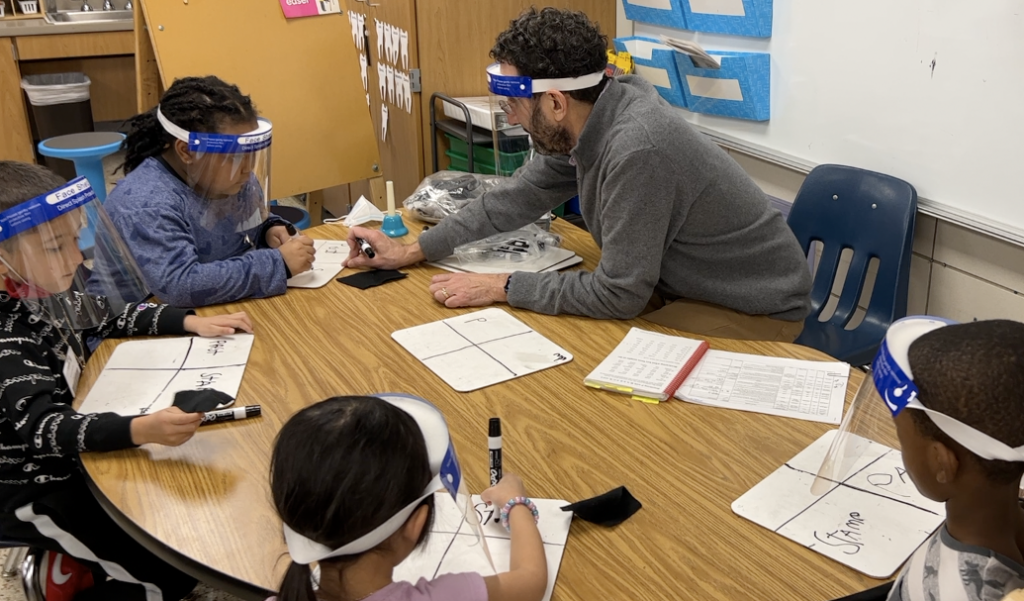Phonics, Phoneme Awareness, and Spelling
Phonics and spelling words is a skill, which requires a small amount of teaching and lots of meaningful practice within the whole learning classroom, in a non-threatening environment. Learning alphabetic writing provides a foundation to understand patterns easily.
Download the Four Page PDF
Phonemic Awareness  Phonemic Awareness is an understanding of speech connecting with print. Children need to be aware of language being broken into words and working with similarities among words (sounds and patterns). Practice is supported with:
Phonemic Awareness is an understanding of speech connecting with print. Children need to be aware of language being broken into words and working with similarities among words (sounds and patterns). Practice is supported with:
- Writing at least several times each day including journals, math logs, pattern writing, with sentence transformation original writing, science, and other writing experiences in the classroom.
- Initially practicing letter formation. Children should be concurrently practicing letters they are learning in spelling.
- Learning to work independently.
- Using word cards for word banks regularly. Have student draw images on the word cards to provide visual cues.
The small amount of teaching phonics and spelling includes:
- Five to ten minutes (short and intensive in an exciting energetic manner) daily using the chalkboards to teach a skill in small groups (3-10)
- Using transitions (approximately two to four minutes in length) to elicit and visually record reoccurring phonetic elements and patterns.
- Students collaboratively recording reoccurring phonetic elements and patterns in their group books.
- Oral language as a foundation for written language.
- Model letter formation to the whole class and individually as needed during practice.
The Learning Spelling Tools
Small whiteboards or desktops as white boards (fun for the students) can be used by the student scholars. The whiteboards can be of various sizes: approximately 30cm x 45cm (12″ x 18″) are very effective for spelling and other learning experiences. Additionally an eraser is important for each student. Additionally multiple students on a large board can be part of the process. It is important to consider how and why they are using their environment (in a circle, at their desks) in consideration of building community and student success.
Introducing the Letter
Letters are taught one at a time. In addition to the small groups with chalkboards, the students will practice in sand, chalk outside, and on paper. The students will practice the name and sound of the letter, how we use our mouth to form the sound, and what the letter represents. The students will write the letters on the chalkboards to build an understanding of the letter. This can be done in whole or small groups. After the students have been introduced to the chalkboards, they will usually work in small groups (4-10 children). The small groups would do their five minutes of spelling while the whole class is doing writing (e.g. pattern writing, journal, original writing, etc.)
Beginning and Ending Sounds
These lessons will provide an opportunity for the students to use and understand the letter(s) at the beginning and end of a word. When introducing the letters with words on chalkboards the students will:
 Hear the word (e.g. learning the letter f the students hear the word fabulous)
Hear the word (e.g. learning the letter f the students hear the word fabulous)- The students will say the word together
- The students will be modeled how their mouths work
- The students will write the letter (e.g. f) in the correct location
- They will self correct if they need to relocate the letter
The boards will be divided into four sections with two lines in each quarter section for beginning and ending sounds.
Words
The students will learn six consonants – e.g. m, s, f, b, t, and c. They will then learn the short a. They will now learn to form words (e.g. bat, cast, act, fact, sat, cab, fast, mat, mast, bats). To write words the students will divide their boards into four sections. They will:
 Hear the word
Hear the word- The students will say the word together
- They will hear a sentence
- They will say the word together
- They will sound and write the word
- They will self correct when needed to correct a spelling
When all four words have been completed, they will be asked to point to any word but the last word. A student will be randomly selected to say their selected word. All students will point to the word, and they will repeat the word. I would suggest that the manner of repeating the word vary in times and delivery to enliven the experience and interest. The teacher will also have a chalkboard as a modeling tool used appropriately when needed.
Multiple Syllable Words
Students will word with multiple syllable words that fit into the foundation of what they have learned (e.g. forget, habit, exit, nutmeg, upset, panic, antic, hotel, etc.). They draw a line under each syllable. This will be modeled.
The children will:
 hear the word
hear the word- say the word together
- clap the syllables
- hear a sentence
- say the word together
- clap the syllables
- draw the lines for syllables
- sound and write the word in syllables (clapping and separating as needed
- write the complete word below the word written in syllables
- self correct when needed to correct a spelling
This will also help students chunk words with their regular writing, especially when they are approximating the word based on the sounds and patterns they know.
It is important for the sequence of introducing and learning the sounds and patterns to be foundational. They need to build on what they know when learning and working with new sounds and patterns. A suggested sequence of teaching letters and patterns is:
- Six consonants
- Short a
- Six more consonants
- Short o
- The s as a plural
- Six more consonants
- Short i
- The remaining consonants except x and qu
- Short u
- Using x and qu
- Short e
- The endings s, ing, y, and er
- Multiple syllable words
- The er, ar, or, ir, and ur sounds
- The ck, ic, le sounds
- The g, ge, dge sounds
- Double consonants including ll, ss, and ff
- The ng patterns including ang, ing, ong, and ung
- The oi and oy patterns
- The ow, ou, and ous patterns
- The long vowel patterns for all five vowels
- The d and ed patterns
- The oo patterns
- Changing y to ies
- The tion pattern
- Prefixes and suffixes
The student(s) will learn to recognize and self correct their writing and spelling. When a student incorrectly spells a word on the chalkboards they will be asked to say (sound) what they have written. They must be looking at the word and sounding what they see, not what they think they remember hearing. It is important to occasionally ask students what they have written when it is correct to assure students are checking themselves and not only responding because the teacher asked. Some exceptions when assistance should be provided include:
• A student writes a k for a c and they have not learned about this particular usage. I would positively recognize their proper usage of the ‘c’ sound and provide them with the correct letter usage.
• A student has the proper sound of (determined when they shared the word) and have reversed the letter (e.g. d & b). I would quickly model the correct orientation.
Observation
The success with spelling is evaluated through observing real life practice with their pattern writing, journal writing, original writing, and visual mapping.
Spelling at Home
If the parents wish to work with their children at home on spelling, I request they visit the classroom where we (the child(ren) and myself) can model how we practice spelling. This assists parents on creating good habits instead of routines that could make spelling more difficult for the child.
Resources
- Marlene and Robert McCracken, Spelling Through Phonics, Peguis Publishers
—highly recommended—
40th Anniversary Edition available on Amazon (October 2022) - Edward Fry, Reading Teacher’s Book of Lists

